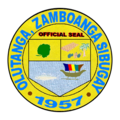Olutanga | |
|---|---|
| Municipality of Olutanga | |
 Map of Zamboanga Sibugay with Olutanga highlighted | |
Location within the Philippines | |
| Coordinates: 7°18′38″N122°50′47″E / 7.31056°N 122.84639°E | |
| Country | Philippines |
| Region | Zamboanga Peninsula |
| Province | Zamboanga Sibugay |
| District | 1st district |
| Barangays | 19 (see Barangays) |
| Government | |
| • Type | Sangguniang Bayan |
| • Mayor | Arthur P. Ruste Sr. |
| • Vice Mayor | Janie Bert D. Gumba |
| • Representative | Wilter W. Palma II |
| • Municipal Council | Members |
| • Electorate | 17,628 voters (2025) |
| Area | |
• Total | 113.30 km2 (43.75 sq mi) |
| Elevation | 12 m (39 ft) |
| Highest elevation | 83 m (272 ft) |
| Lowest elevation | 0 m (0 ft) |
| Population (2024 census) [3] | |
• Total | 34,124 |
| • Density | 300/km2 (780/sq mi) |
| • Households | 8,125 |
| Economy | |
| • Income class | 4th municipal income class |
| • Poverty incidence | 27.55 |
| • Revenue | ₱ 191.5 million (2022) |
| • Assets | ₱ 501.8 million (2022) |
| • Expenditure | ₱ 138.2 million (2022) |
| • Liabilities | ₱ 210.2 million (2022) |
| Service provider | |
| • Electricity | Zamboanga del Sur 2 Electric Cooperative (ZAMSURECO 2) |
| Time zone | UTC+8 (PST) |
| ZIP code | 7041 |
| PSGC | |
| IDD : area code | +63 (0)62 |
| Native languages | Subanon Cebuano Chavacano Tagalog |
| Website | www |
Olutanga, officially the Municipality of Olutanga (Cebuano : Lungsod sa Olutanga; Chavacano: Municipalidad de Olutanga; Tagalog : Bayan ng Olutanga), is a municipality in the province of Zamboanga Sibugay, Philippines. According to the 2020 census, it has a population of 38,438 people. [5]
Contents
- Geography
- Barangays
- Climate
- Demographics
- Economy
- Educational institutions
- Tertiary
- High schools
- Elementary
- Primary
- References
- External links
The municipality is in the southwestern part of the eponymous Olutanga Island.



